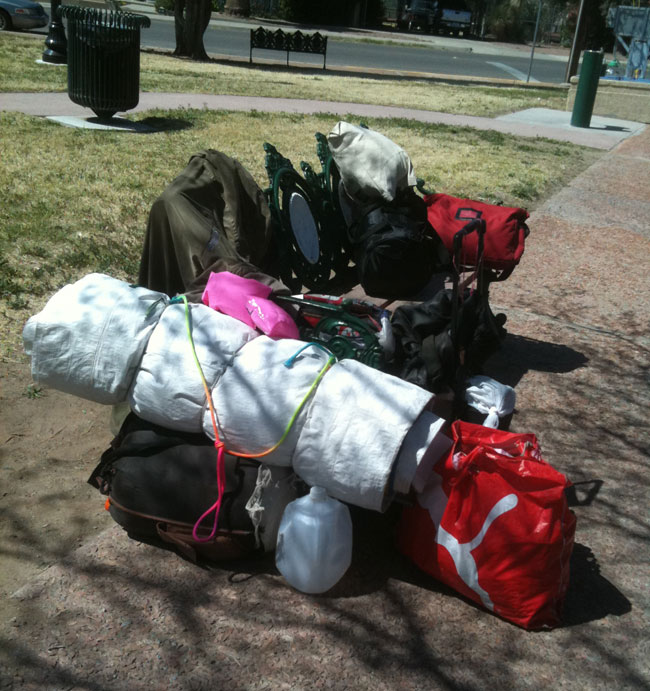EL PASO, Texas — Homelessness has been an ongoing problem for many years in the United States, and many only see what’s on the surface, a person usually begging for spare change.
The unseen reality is that in the United States about 3 million people are homeless and the recession will leave about 1.5 million more people without a roof over their heads over the next two years, according to The National Alliance to End Homelessness.

A homeless' belongings set on a park bench at Sunset Heights, El Paso. (Lourdes Cueva Chacón/Borderzine.com)
The stereotype of a homeless person is someone who is too lazy to get a job or is a drug addict. Although there are people who choose to be on the streets and there are those with a serious dependency problem, about 41 percent of those who are homeless are families and about 1.5 million children were homeless just last year according to the National Center of Family Homelessness.
“The homeless are as diverse as the rest of the population,” said Dr. Randall Amster, professor of Peace Studies at Prescott College and executive director of the Peace and Studies Association. “Some are lazy, but many are very industrious and hard-working. Increasingly, the homeless include people that were recently regular middle-class working people, and entire families are becoming homeless as well.”
Amster believes society’s view of homelessness is due to the “part of a capitalist mythology that everyone can make something of themselves, and if they don’t it’s their own fault.” In reality, unemployment, poverty, and lack of affordable housing are some of the contributors for families who are homeless.
In 2000, a report by the Department of Housing and Urban Development (HUD) found that 5.4 million low-income families were paying more than half of their annual income on housing. Something affordable for a low-income family should only be costing about 30 percent of their income.
The fact that the manufacturing of homes has decreased dramatically does not help either. In 2001, HUD reported 193,120 homes built, compared to only 49,683 in 2009. Over a period of 10 years there has been a 90 percent decline in the manufacturing of homes and the most affected are low in-come families looking for affordable housing.
In addition, many low-income families are being forced to leave their houses due to governments using eminent domain laws to appropriate private property or gentrification. Homes will be destroyed and replaced by entertainment outlets for the wealthy.
“Relocation is another way to push them out,” said Teresa Hibbert, lecturer at UTEP’s Department of Sociology and Anthropology.
Hibbert said families would be relocated in areas that least benefit them, away from work and schools. They most likely lack transportation, which will make it harder to get to work or schools.
Those who are not lucky and have not other option but to live in the street are finding it harder to find a place to sleep.
Amster discussed in a lecture held at UTEP that laws are being passed that are aimed at the homeless. In some cites it is illegal to sit or lie down on a sidewalk. The controversial ordinance may soon be passed big cities such as Portland and San Francisco. Many believe that the “sit-lie” law is aimed at the homeless because their only place to live is on a public place.
Politicians claim that the law is not aimed at homeless. They say it is to prevent fights from street kids or gangs, but Amster believes the law is unjust.
“Order and safety may be important aims, but so are fairness and humanity,” Amster said. “We shouldn’t be placed in a position where we have to sacrifice the latter in the name of the former.”
Even though programs to help the homeless are scarce, there are organizations like the Salvation Army that help house those in need.
John Martin, director of business operations of the Salvation Army in El Paso says that there are about 70 individuals that are being sheltered, 50 of them are children, but the facility is able to house 106 individuals. The shelter often is at capacity during the summer Martin said.
Not only do they provide shelter and food, but the Salvation Army helps them get back on their feet.
“We work with individuals on a 90 day plan,” said Martin. “Right now 80 percent of our families do move on to better housing.”
The Salvation Army works closely with other organization to alleviate homelessness in the community and if individuals need psychiatric counseling it refers them to other services available locally.
Catherine Phelps was living in a hotel with her family before she sought help at the Salvation Army. There she has been able to get her and her family’s life back on track due to the shelter.
“I was able to get my ID, my son’s ID; my surgery done; my husband’s health issues taken care of; and I have a job, which I didn’t even know I could be employed because I filed for disability,” said Phelps. “I’ve got a lot of health problems and through here I found out that there’s places that hire people with disabilities.”
The shelter also received food donations from the community that helps feed about 200 families.
There are many similar cases. Many homeless, become destitute because of high medical expenses.
The economic recession has been devastating to millions of Americans but slowly the government is taking charge. The Obama Administration gave HUD a 10.8 percent funding increase over last year’s, that will “increase will enable the Department to respond aggressively to the housing crisis… community revitalization and poverty alleviation.”
Homeless people are very present in every community, yet they remain unnoticed.
“The homeless are just like everyone else, with hopes and dreams and complex emotions. We often fail to see their basic humanity, and in the process we lose part of our own as well,” Amster said.


I am writing a community report on the increase of homelessness in the country and in the city. I am a freshman UTEP student attending. I just wanted to thank you for making this information available it was very helpful hopefully other students in the future interested in the homeless topic can obtain such good information on what our city is taking charge on.
sincerely Armando